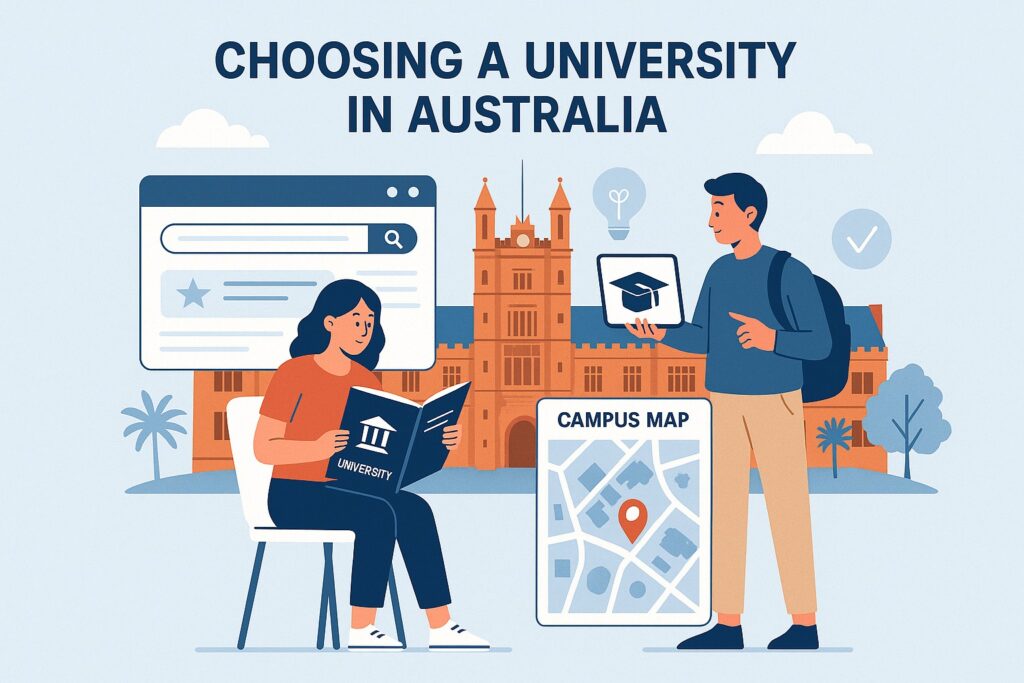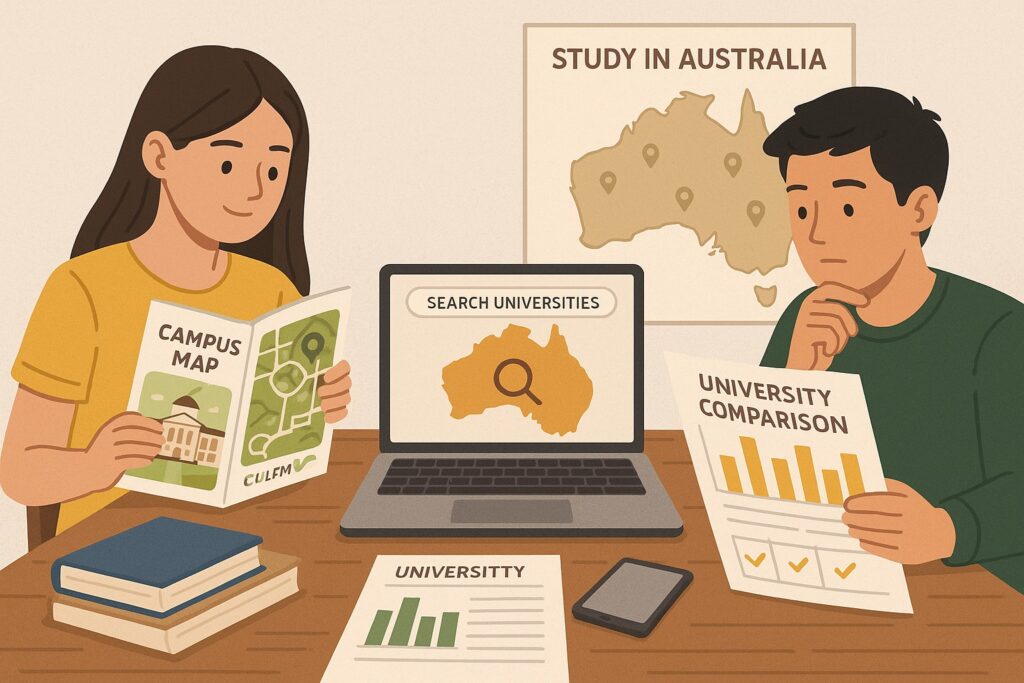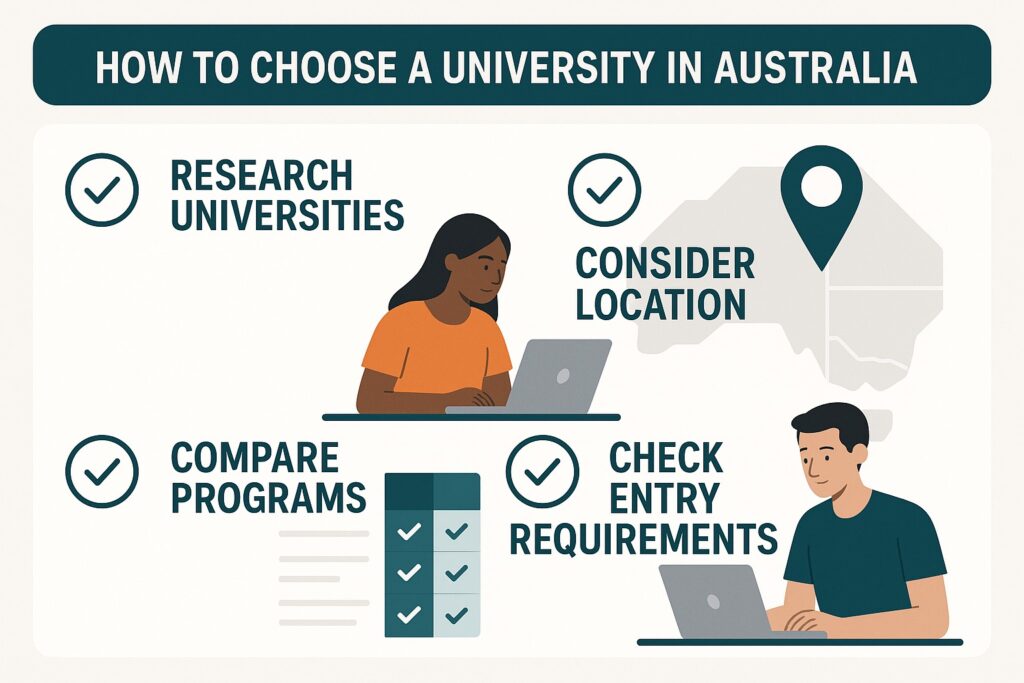Table of Contents
Introduction
Choosing the right university in Australia is one of the most important decisions for any prospective international student. With over 43 universities and more than 22,000 courses available, Australia offers a diverse and dynamic higher education landscape. According to the Overseas Students Guide Australia 2023, international students continue to flock to Australia for its world-class education, vibrant student cities, and global career opportunities.
In this comprehensive guide, you’ll learn how to navigate the process of selecting the ideal university in Australia. We’ll cover key factors such as rankings, course offerings, campus locations, costs, entry requirements, and support services. Whether you’re aiming for academic prestige, industry connections, or a unique campus experience, this article will help you make an informed, confident choice for your future.

Background & Context
Australia’s higher education system is recognized globally for its quality and innovation. The country is home to 43 universities, with at least one main campus in each state or territory. In March 2020, over 626,000 international students were studying in Australia, highlighting its appeal as a top study destination.
Australian universities are known for their research output, industry partnerships, and diverse student communities. They offer a wide range of programs across fields such as business, engineering, health sciences, IT, and the arts. The Australian Qualifications Framework (AQF) ensures that degrees are standardized and recognized worldwide.
When choosing a university in Australia, students must consider factors such as location, course availability, tuition fees, living costs, entry requirements, and campus culture. Each university has its own strengths, specializations, and support services, making it essential to research and compare options carefully.
The decision-making process can be complex, but with the right information and a clear understanding of your goals, you can find the perfect fit for your academic and personal aspirations.
Key Steps to Choosing the Right University in Australia
Step 1: Define Your Academic and Career Goals
Before you start comparing universities, it’s crucial to clarify your academic interests and long-term career objectives. Consider the following:
- Field of Study: What subject or discipline are you passionate about? Australia offers programs in business, engineering, health, IT, arts, and more.
- Career Pathways: Research how different universities support your desired career, including internships, industry placements, and graduate employment rates.
- Specializations: Some universities are renowned for specific fields. For example, UNSW is a leader in technological research, while the University of Sydney excels in health sciences and the arts.
Example:
If you aim to work in renewable energy, look for universities with strong engineering faculties and research centers focused on sustainability.
Step 2: Research University Rankings and Reputation
University rankings can provide valuable insights into academic quality, research output, and global reputation. However, they should be considered alongside other factors.
- Global Rankings: Australian universities like the University of Melbourne, University of Sydney, and Australian National University consistently rank among the world’s top 50.
- Subject Rankings: Some universities may rank higher in specific disciplines. Use subject-based rankings to identify the best fit for your chosen field.
- Reputation with Employers: Research how employers perceive graduates from different universities.
Example:
A student interested in business may prioritize universities with strong connections to the financial sector and high graduate employability rates.
Step 3: Evaluate Course Offerings and Flexibility
Not all universities offer the same courses or specializations. Review the following:
- Course Structure: Examine the curriculum, core subjects, electives, and practical components.
- Double Degrees and Minors: Some universities allow you to combine degrees or add minors for broader skill sets.
- Online and Flexible Options: Many universities now offer online or hybrid learning for added flexibility.
Example:
A student who wants to combine IT and business may seek a university offering double degrees or joint programs.
Step 4: Consider Location and Campus Life
Location plays a significant role in your overall experience. Think about:
- City vs. Regional: Major cities like Sydney, Melbourne, and Brisbane offer vibrant student life, while regional campuses may provide a quieter, more affordable environment.
- Climate and Lifestyle: Australia’s climate varies by region, from temperate in Melbourne to subtropical in Brisbane.
- Campus Facilities: Look for modern libraries, research labs, sports facilities, and student accommodation.
Example:
A student who enjoys outdoor activities might prefer universities near beaches or national parks, such as those in Perth or the Gold Coast.
Step 5: Understand Costs and Scholarships
Studying in Australia involves both tuition fees and living expenses. According to the Overseas Students Guide Australia 2023:
- Tuition Fees: Vary by university and course, typically ranging from AUD $20,000 to $45,000 per year for international students.
- Living Costs: Average monthly expenses for a student in shared accommodation are around AUD $2,150 in cities like Sydney.
- Scholarships: The Australian government and universities offer a range of scholarships based on merit, need, or specific fields of study.
Example:
A student with a strong academic record can apply for scholarships that cover tuition, living expenses, or both
Step 6: Check Entry Requirements and English Proficiency
Each university sets its own academic and English language requirements:
- Academic Entry: Based on previous qualifications (high school, diploma, or undergraduate degree).
- English Proficiency: Most universities require IELTS, TOEFL, or equivalent scores. Minimum requirements typically range from IELTS 6.0 to 7.0, depending on the course.
- Genuine Temporary Entrant (GTE) Statement: A requirement for student visa applicants to demonstrate genuine intent to study.
Example:
A student applying for a postgraduate course in engineering may need an undergraduate degree in a related field and an IELTS score of 6.5 or higher.
Step 7: Explore Support Services and Student Life
Support services can make a big difference in your academic success and well-being:
- Orientation Programs: Help new students settle in and understand university systems.
- Academic Support: Tutoring, writing centers, and study workshops.
- Career Services: Guidance on internships, job applications, and networking.
- Wellbeing and Counseling: Mental health support, social clubs, and multicultural societies.
Example:
A university with a dedicated international student center can provide assistance with visas, accommodation, and cultural adjustment.

Analysis & Insights
The Overseas Students Guide Australia 2023 emphasizes that choosing the right university in Australia is a holistic process. While rankings and reputation matter, personal fit, course content, and support services are equally important.
- Diversity of Choice: With 43 universities and thousands of courses, students can tailor their education to match their goals.
- Global Recognition: Australian qualifications are respected worldwide, opening doors to international careers.
- Industry Connections: Many universities have strong ties to local and global industries, enhancing employability.
- Student Experience: Vibrant campus life, multicultural communities, and comprehensive support contribute to a rewarding study journey.
A thoughtful, research-driven approach ensures you select a university that aligns with your academic ambitions and personal preferences.
Practical Applications
To apply these insights in your university search:
- List Your Priorities: Rank factors like course quality, location, costs, and campus culture.
- Use Official Resources: Visit university websites, attend virtual open days, and read student testimonials.
- Compare Options: Create a shortlist based on your criteria and compare using online tools or comparison tables.
- Seek Advice: Consult education agents, alumni, or current students for firsthand perspectives.
- Prepare Your Application: Gather required documents, check deadlines, and ensure you meet entry requirements.
By following these steps, you’ll be well-equipped to make an informed, confident decision about your university in Australia.

Benefits & Outcomes
Selecting the right university in Australia leads to:
- Academic Excellence: Access to high-quality teaching and research.
- Career Opportunities: Strong industry links and high graduate employability.
- Personal Growth: Exposure to diverse cultures and experiences.
- Long-Term Value: Globally recognized qualifications and potential migration pathways.
A well-chosen university sets the foundation for lifelong success and fulfillment.
Future Considerations
The landscape of higher education in Australia is evolving:
- Digital Learning: Growth of online and hybrid programs increases flexibility.
- Sustainability: Universities are focusing on green campuses and sustainable practices.
- Global Collaboration: Increased international partnerships and exchange opportunities.
- Student Wellbeing: Enhanced support for mental health and holistic development.
Staying informed about these trends will help you choose a university that prepares you for the future.
Conclusion
Choosing the right university in Australia is a pivotal step in your academic and professional journey. By considering your goals, researching options, and leveraging the insights from the Overseas Students Guide Australia 2023, you can find the perfect match for your ambitions.
Start your search today, compare your options, and take the next step toward a rewarding experience at a university in Australia. Your future begins with the right choice.
Frequently Asked Questions
What are the main factors to consider when choosing a university in Australia?
Key factors include course offerings, university rankings, location, costs, entry requirements, and support services. Align these with your academic and career goals for the best fit.
How important are university rankings in Australia?
Rankings provide useful insights but should be balanced with personal preferences, course content, and campus culture. Subject-specific rankings can help identify strengths in your chosen field.
What are the typical entry requirements for Australian universities?
Entry requirements vary by course and university but generally include academic qualifications and English proficiency (IELTS, TOEFL, etc.). Some programs may require additional tests or portfolios.
Are scholarships available for international students in Australia?
Yes, the Australian government and universities offer a range of scholarships based on merit, need, or specific disciplines. Check eligibility and application deadlines on official university websites.
How can I compare different universities in Australia?
Use official university websites, online comparison tools, and attend virtual open days. Create a shortlist based on your priorities and seek advice from alumni or education agents.
Internal Links
- Explore our guide on Australian university rankings
- Learn more about scholarships for international students
- Discover tips for student life in Australia
- Read about entry requirements for studying in Australia
External Links
- Australian Government Study in Australia
- QS World University Rankings: Australia
- Australian Qualifications Framework
Australia offers 43 universities and over 22,000 courses—choose your perfect fit for global success!





